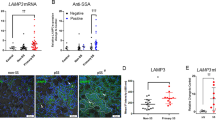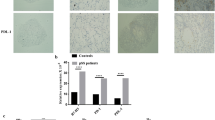Abstract
Expressions of the effector molecules of Fas-mediated apoptosis in primary cultured salivary gland epithelial cells (SGEC) of primary Sjögren’s syndrome (pSS) remain to be clarified. We focused on Fas-mediated caspase cleavage compared to tumor necrosis factor-related apoptosis inducing ligand (TRAIL)-mediated apoptosis. Induction of apoptosis was performed by anti-Fas antibody coupled with PI3K inhibitor, or TRAIL. Activation of caspases, cytochrome C, and apoptotic protease activating factor-1 (Apaf-1) was determined by western blotting or immunofluorescence observed by confocal microscopy. Fas-mediated apoptosis and activation of caspase 3/8 were induced in the presence of LY294002. TRAIL-induced apoptosis in SGEC, which was stronger than that induced by anti-Fas antibody. TRAIL-induced caspase 9 cleavage accompanied by activation of cytochrome C and Apaf-1 were not mediated by anti-Fas antibody. Our results suggest that death receptor-dependent apoptosis in primary cultured SGEC is regulated by the engagement of type II cells in pSS.






Similar content being viewed by others
Abbreviations
- Apaf-1:
-
Apoptotic protease activating factor-1
- EGF:
-
Epidermal growth factor
- FITC:
-
Fluorescein isothiocyanate
- LSG:
-
Labial salivary glands
- PBS:
-
Phosphate-buffered saline
- PI3K:
-
Phosphatidylinositol 3-kinase
- pSS:
-
Primary Sjögren’s syndrome
- SGEC:
-
Salivary gland epithelial cells
- TRAIL:
-
Tumor necrosis factor-related apoptosis inducing ligand
- TRITC:
-
Tetramethyl rhodamine isothiocyanate
- TUNEL:
-
Terminal deoxynucleotidyltransferase-mediated dUTP nick end-labeling
References
Fox RI (2005) Sjögren’s syndrome. Lancet 366(9482):321–331. doi:10.1016/S0140-6736(05)66990-5
Nakamura H, Kawakami A, Eguchi K (2006) Mechanisms of autoantibody production and the relationship between autoantibodies and the clinical manifestations in Sjögren’s syndrome. Transl Res 148:281–288. doi:10.1016/j.trsl.2006.07.003
Pan G, O’Rourke K, Chinnaiyan AM et al (1997) The receptor for the cytotoxic ligand TRAIL. Science 276(5309):111–113. doi:10.1126/science.276.5309.111
Nakamura H, Kawakami A, Ida H, Koji T, Eguchi K (2007) EGF activates PI3 K-Akt and NF-kappaB via distinct pathways in salivary epithelial cells in Sjögren’s syndrome. Rheumatol Int 28:127–136. doi:10.1007/s00296-007-0411-9
Nakamura H, Kawakami A, Ida H, Koji T, Eguchi K (2007) Epidermal growth factor inhibits Fas-mediated apoptosis in salivary epithelial cells of patients with primary Sjögren’s syndrome. Clin Exp Rheumatol 25:831–837
Scaffidi C, Fulda S, Srinivasan A et al (1998) Two CD95(APO/Fas) signaling pathways. EMBO J 17:1675–1687. doi:10.1093/emboj/17.6.1675
Kischkel FC, Hellbardt S, Behrmann I et al (1995) Cytotoxicity-dependent APO-1 (Fas/CD95)-associated proteins form a death-inducing signaling complex (DISC) with the receptor. EMBO J 14:5579–5588
Li H, Zhu H, Xu CJ, Yuan J (1998) Cleavage of BID by caspase 8 mediates the mitochondrial damage in the Fas pathway of apoptosis. Cell 94:491–501. doi:10.1016/S0092-8674(00)81590-1
Gao J, Cha S, Jonsson R, Opalko J, Peck AB (2004) Detection of anti-type 3 muscarinic acetylcholine receptor autoantibodies in the sera of Sjögren’s syndrome patients by use of a transfected cell line assay. Arthritis Rheum 50:2615–2621. doi:10.1002/art.20371
Steinfeld S, Cogan E, King LS, Agre P, Kiss R, Delporte C (2001) Abnormal distribution of aquaporin-5 water channel protein in salivary glands from Sjögren’s syndrome patients. Lab Invest 81:143–148
Vitali C, Bombardieri S, Jonsson R et al (2002) Classification criteria for Sjögren’s syndrome: a revised version of the European criteria proposed by the American-European Consensus Group. Ann Rheum Dis 61:554–558. doi:10.1136/ard.61.6.554
Li P, Nijhawan D, Budihardjo I et al (1997) Cytochrome c and dATP-dependent formation of Apaf-1/caspase-9 complex initiates an apoptotic protease cascade. Cell 91:479–489. doi:10.1016/S0092-8674(00)80434-1
Luo X, Budihardjo I, Zou H, Slaughter C, Wang X (1998) Bid, a Bcl2 interacting protein, mediates cytochrome c release from mitochondria in response to activation of cell surface death receptors. Cell 94:481–490. doi:10.1016/S0092-8674(00)81589-5
Krammer PH (2000) CD95’s deadly mission in the immune system. Nature 407(6805):789–795. doi:10.1038/35037728
Jimenez F, Aiba-Masago S, Al Hashimi I et al (2002) Activated caspase 3 and cleaved poly(ADP-ribose)polymerase in salivary epithelium suggest a pathogenetic mechanism for Sjögren’s syndrome. Rheumatology (Oxford) 41:338–342. doi:10.1093/rheumatology/41.3.338
Ohlsson M, Skarstein K, Bolstad AI, Johannessen AC, Jonsson R (2001) Fas-induced apoptosis is a rare event in Sjögren’s syndrome. Lab Invest 81:95–105
Kong L, Ogawa N, Nakabayashi T et al (1997) Fas and Fas ligand expression in the salivary glands of patients with primary Sjögren’s syndrome. Arthritis Rheum 40:87–97. doi:10.1002/art.1780400113
Matsumura R, Umemiya K, Kagami M et al (1998) Glandular and extraglandular expression of the Fas-Fas ligand and apoptosis in patients with Sjögren’s syndrome. Clin Exp Rheumatol 16:561–568
Nakamura H, Koji T, Tominaga M et al (1998) Apoptosis in labial salivary glands from Sjögren’s syndrome (SS) patients: comparison with human T lymphotropic virus-I (HTLV-I)-seronegative and -seropositive SS patients. Clin Exp Immunol 114:106–112. doi:10.1046/j.1365-2249.1998.00692.x
Acknowledgments
The authors would like to thank Dr. Noriyoshi Ogawa from the Third Department of Internal Medicine, Hamamatsu Medical University, for advice regarding the primary cell culture of epithelial cells obtained from minor salivary gland biopsy.
Author information
Authors and Affiliations
Corresponding author
Rights and permissions
About this article
Cite this article
Nakamura, H., Kawakami, A., Iwamoto, N. et al. Rapid and significant induction of TRAIL-mediated type II cells in apoptosis of primary salivary epithelial cells in primary Sjögren’s syndrome. Apoptosis 13, 1322–1330 (2008). https://doi.org/10.1007/s10495-008-0261-2
Published:
Issue Date:
DOI: https://doi.org/10.1007/s10495-008-0261-2




